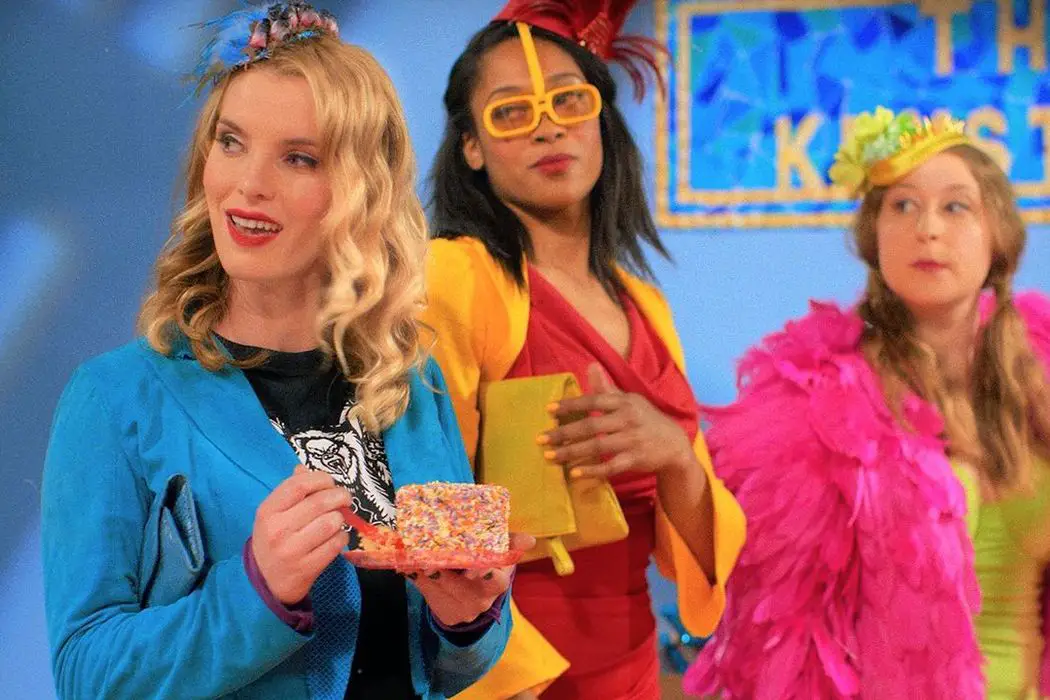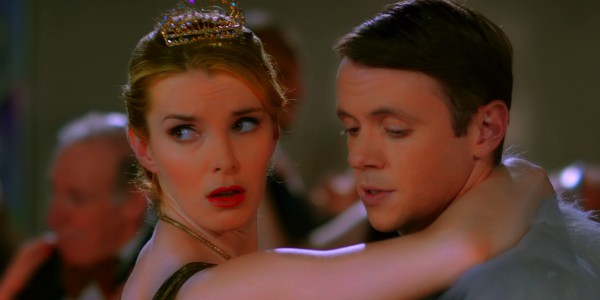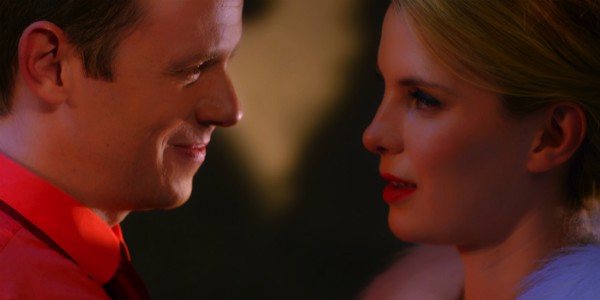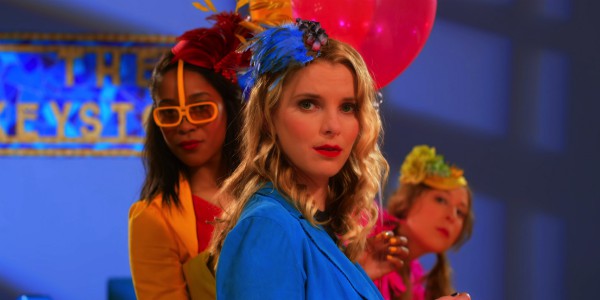FUTURE ’38: Building A Unique World From Genre Tropes

Amanda Mazzillo is a writer with an MFA in Dramatic…
Future ’38, Jamie Greenberg’s experimental period piece, manages to capture the essence of the screwball comedy, as well as B-movie sci-fi films through its unique blend of modern and old-fashioned sensibilities. Future ’38 follows Essex (Nick Westrate), an American agent sent into the future to recover an isotope, which will be as strong as the atomic bomb, after it matures for 80 years, which puts him in 2018. Once in the future, Essex meets Banky (Betty Gilpin), a hotel clerk, who joins him on his journey through a New York City similar to our own, but mixed together with the sensibilities of the 1930s.
The film is framed by a faux movie special where Neil deGrasse Tyson introduces the film as one of the first color pictures, predating The Wizard of Oz and Gone with the Wind. This structure helps the audience know exactly what type of ridiculous fun the film has in store. When the opening credits began to run after this introduction, I was already impressed by the stylistic similarity between this film and the 1930s films from which it was inspired.
Strength Through Similarities

One of the strongest aspects of Future ’38 is its dedication to accurately emulating the films and genres from which it is inspired. Future ’38 feels as close to a film made in the era in which it is set more than most other period cinema. For a film such as this, I think this was a wonderful direction to go in, and the framing device made the film feel cohesive and original.
Using a framing device like this reminded me of the classic comedy, The Princess Bride. I do like how the device is revisited within The Princess Bride, but I think the way Future ’38 uses this similar device adds to its realism as a film of the time period. We are used to film specials on television opening with backstory, especially if a film had been lost for a number of years, so this framing made Future ’38 feel very reminiscent of the films and introductions one would see on TCM.
Future ’38 utilizes tropes of screwball comedy and B-movie sci-fi films in order to build a unique and interesting world at the center of the film’s action. The originality of the film comes from the delightfully derivative way in which it captures a long-past era. Everything from the camera work, dialogue, performances, and costumes, all the way to the opening credits is wonderfully reminiscent of the films which worked as inspiration for Future ’38.
Both Nick Westrate and Betty Gilpin portray their characters with an authenticity and affection for the performances found in screwball comedies. Westrate’s delivery does not sound like a forced impression of the way actors talked in those films, but instead comes across rather naturally, while capturing all the elements which made the speed and style of speaking unique during the screwball comedy era.

Even though both their characters are essentially 1930s actors portraying the characters we see in the film, the tone and style of their speech differ slightly, making the scenes of them together that much stronger. Subtle differences in their deliveries drove their performances to another level. Westrate’s delivered his dialogue with just enough more speed and style, while Gilpin’s delivery range true to the performances in screwball comedies, yet felt slightly more subtle, like she’s been far-removed from the 1930s, yet still retains their sensibilities, much like the future imagined in Future ’38.
Future ’38 does a wonderful job of using the film-making techniques of today to capture the feel of the film from 1938. The aspect ratio, shot choices, and color scheme are all reminiscent of films of the past. The film manages to recreate the visual and aural imperfections found in older films. Every little imperfect moment in this film feels like it belongs, and it all works together to capture the essence of watching an older film.
Comedy from an Imagined Future
A fair amount of the comedy in Future ’38 comes from the similarities of this imagined future to both our present and the past. The mixture of ideas futuristic and realistic to our transplanted protagonist offers a glimpse into how our future might be imagined by someone from the 1930s. With a concept such as this, Future ’38 manages to create a fun and unique film playing this up, while crafting a memorable B sci-fi plot.
If Future ’38 had the future our protagonist comes into dominated by traditional ideas from countless science fiction films, even if they were done in the 1930s style, the film would never have been as interesting and memorable as it is with its exploration of a futuristic daily life. One of the only typical futuristic elements in the imagined future is a robot, which happens to be the most old-fashioned element of the future presented in the film.

Future ’38 does a wonderful job of combining our world and the world of the 1930s in the choices of futuristic elements our protagonist is amazed by when he lands in 2018. One joke I found particularly funny is about portable and television phones, which look like our modern flat screens and smart phones, yet on the screen is black and white footage of a telephone operator, portrayed wonderfully by Sean Young. When Banky wants to find out what time it is from her phone, she has to ask the operator. This moment works very well, in combining our world and the 1930s.
Another scene I found especially funny when combining these two different worlds involved a computer cafe, where Essex must go in order to get the answers he needs. The computer inside is big and clunky, and everyone must wait in a line in order to ask their questions and have the answers printed out on ticker tape. This scene is made even better when Banky complains about wasting her time online, and she is refereeing to the line you must wait in to ask your question.
As the film moves forward, these types of jokes, as well as quick paced screwball comedy one-liners punctuate the film, providing a signature and remarkable tone throughout the film. Westrate and Gilpin work well off each-other, trading back quick lines of witty dialogue with a natural chemistry, made even better with their fast-paced and period-accurate delivery.
Conclusion: Future ’38
Future ’38 is a memorable adventure which perfectly reflects our time, as well as reminisces about the films and sensibilities of the past.
What did you think of Future ’38? Did you think it accurately captured films of the 1930s? Which other films do you think have captured the style of the era in which they were set?
Future ’38 had a limited US release on December 1st, 2017, and is coming to VOD on January 2, 2018. More information here.
Does content like this matter to you?
Become a Member and support film journalism. Unlock access to all of Film Inquiry`s great articles. Join a community of like-minded readers who are passionate about cinema - get access to our private members Network, give back to independent filmmakers, and more.
Amanda Mazzillo is a writer with an MFA in Dramatic Writing from SCAD and a BA in Writing & Linguistics and Film Studies minor from Georgia Southern University. She enjoys writing comedy and exploring all forms of media. Her Twitter name is a bad pun: @mazzillofirefox













